Artful LearningBlogBlog 15: Movement & Dance
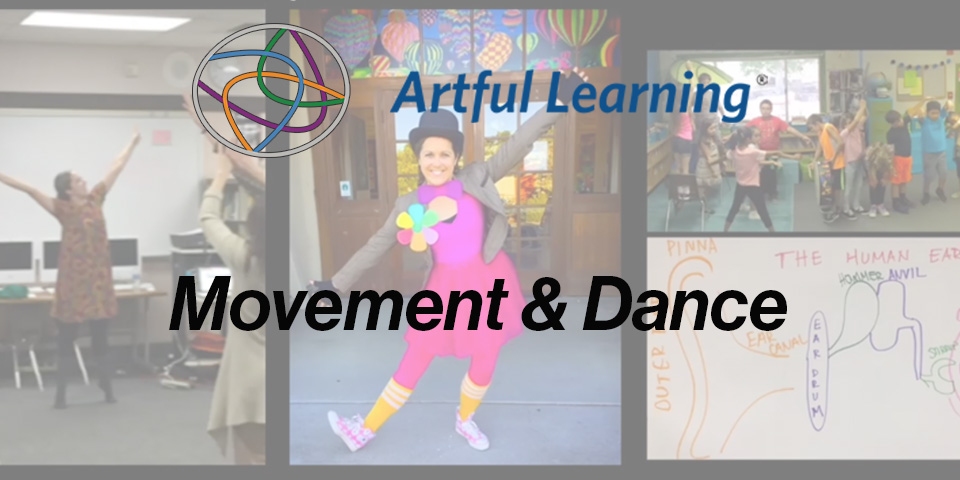
September 21, 2020
Movement & Dance
“Trust is the foundation for everything we do. If we hold back who we are, we are less likely to be trusted.” - Frances Frei, Professor at Harvard Business School.
Shannon Hattyar provided an excellent presentation on how to incorporate movement and dance in the classroom during our professional development with the educators at Dwight Rich School of the Arts. It was a very engaging experience that had everybody moving in the morning! Hattyar uses the following exercises in her own fourth-grade classroom and one of the first ones she demonstrated was the “warm-up.” The warm-up is important because it sets the tone for the day and allows the students to “get their jitters out” before instruction. Some of the warm-ups include taking deep breaths in and out, using one’s shoulders to tense up and relax, and an exercise that uses the whole body called “crazy eights.”
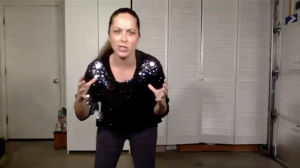
Hattyar’s dance background is instrumental in the way she teaches. She is very aware of how movement and dance can add to the academic development of her students—as well as to their motor skills. One of the ways she does this is through “body awareness,” which encompasses what the body is doing. She teaches her students this by having them do exercises that use the whole body like “jump, spin, and freeze.” She does this by allowing her class to create specific symbols for these moves and she has them act them out when the symbols are presented. Hattyar also uses the same method with isolated actions of a particular part of the body by having them use moves like “reach, punch, and kick.” These simple yet specific moves encourage students to understand what they are capable of doing with their bodies and, of course, it is a great way to see if they are following directions.
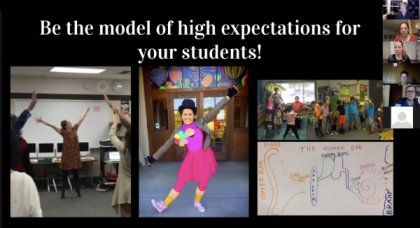
Another way that Hattyar uses movement with her students is through “effort awareness,” which is how the body is moving. She teaches her students that there are many ways they can use their bodies when they are moving. These ways include adjusting the weight, time, space, and flow of how one uses their body. She will often ask her students “if their punches are firm or are they floating?” “Are they moving fast or are they moving slow?” “Are their moving limbs curved or are they linear?” These differentiating questions encourage her students to move with purpose and authority. Hattyar also uses “spatial awareness” with her class, which means where the body is moving. She teaches her students that they have complete control of where they move their bodies and that this can include a change in direction, change in level, using one’s personal space or general space, and where exactly they are extending into. This demonstrates that her students have agency with their bodies and they have control over their creative expression.
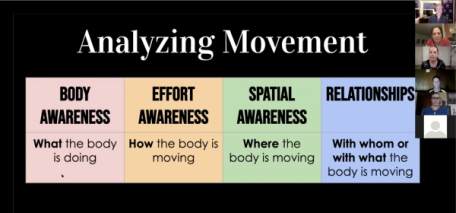
In order to combine all of the different types of awareness, Hattyar emphasizes the five focal movements that are fundamental in dance. Each of these movements uses body awareness, effort awareness, and spatial awareness together. These dance movements are: expand, compress, reach, constrain, and rhythmic repeat and they are essentially building blocks to all types of choreography. She teaches her students these specific moves because “meaningful movement can be contrived by gesture and posture” and that “expression can be portrayed through the intentional transfer of weight and energy.” One of Hattyar’s favorite movement exercises is the Art-Based Skill and Strategy called “Mirroring.” Mirroring is a popular and common practice that often occurs in the theatre environment. This exercise has a “leader” guide their “followers” to mirror their movements using their entire bodies—while also noting any specific gestures or facial expressions. Mirroring uses one’s concentration and observational skills to improve movement, muscle control, and spatial awareness. It also taps into the students’ mirroring neurons and develops nonverbal communication between the leader and the followers.
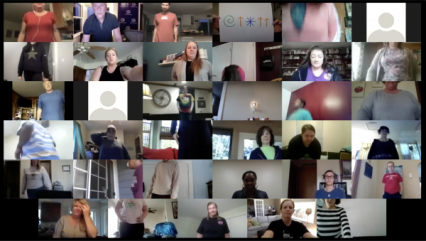
Hattyar also teaches her students some great “visual thinking strategies” and one of them is having a learner-centered classroom discussion about any type of visual text. There are not necessarily any wrong or right answers with these types of discussions because the students are making assumptions based on what they see. The teacher can guide the discussions by asking “what is going on in the image,” “what do you see that makes you say that,” and “what more can you find?” These types of questions allow students to interpret different types of artistic images and facilitates a deeper level of critical thinking. It can also help create a sense of community within the classroom because students can hear other responses and build upon those ideas to generate their own.
Hattyar has some wonderful tools at her disposal when it comes to incorporating movement and dance within an Artful Learning curriculum. Can you see yourself using some of these examples in your own classroom?